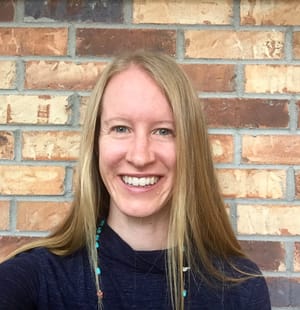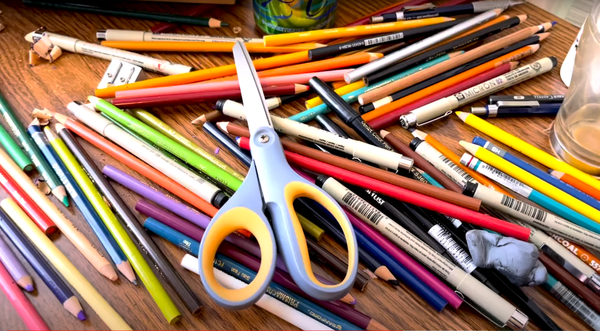When considering my topic for these field notes, I was nudged in the direction of exploring my experience with corporate instructional design compared with my past work in higher education instructional design. I appreciate the nudge because this is a fun topic to consider. Higher education and corporate are often presented as two different types of entities. For the most part, I see why. I wanted to test out whether or not this thought is true by reflecting on my internship experience and analyzing the words I'd use to describe what I'm learning. I study English Writing, Rhetoric, and Technology, so a deep dive into language fits me well.
As a bit of background, some might call me a non-traditional student. Others may say I’m new-traditional. Either way, on campus, people often mistake me for faculty. In my prior work life, “faculty” was accurate. For over twenty years, I taught in higher education: mostly community college. I designed my own courses, but I also helped other faculty design theirs. As a teacher, I was still always a learner (my first Clifton Strength describes me as a “learner,” followed by “developer,” which seems appropriate for someone interested in instructional design). My student role, however, gives me the opportunity to prioritize my learning in a different way. I feel privileged to be here at this point, writing these field notes.
As someone who has been connected to higher education in one form or another continuously since graduating high school, I have heard the conversations where higher education is described as being significantly different from everything else: it's unique. It has its own way of doing things. Reflecting on my practice, I see significant commonality between corporate approaches and higher education approaches to instructional design.
I summed up my observations in a diagram.
Before I share it with you, I want to explain that my observations are simplified. I did not effectively capture nuance. To remedy the lack of universality a bit, I included a note to remind the reader that all corporate and higher education instructional design experiences may be different. I urge the reader to look at my graphic as a reflection of my own experiences right now as an intern for the Learning Agency. It’s a starting point for a conversation. It looks like this:
After my first round of analysis, concerns arose in me about the overall message: the message that corporate and higher education instructional design are quite different. I’m not sure if this is what I want to suggest.
Language Choices
Words are powerful. When I was coming up with a title for this post, I decided on this collection of words: “Corporate and/or Higher Education Instructional Design.” I chose “and/or” on purpose because of my inclination to place these two kinds of instructional design in connection with one another rather than in opposition. After my experience in corporate instructional design, I wonder if this is all more of a both/and situation. If I change my graphic and take away the differences and highlight only what’s the same, the central elements shine through. These are the things that instructional designers need: they are the process.
The differences between higher education and corporate instructional design are mostly related to the product. Product and process are both important, of course. The tangible part of my work consists of deliverables that have a certain feel, function, and look to them. However, I wonder if my focus on the product differences creates a binary when, at the heart of it, there’s more in common.
Going back to the graphic I created, reducing something holistic into bulleted lists was a helpful exercise, because when I look at the differences, I start to notice that things that seem opposite are maybe the same. Let me explain.
Course Policies
Course policies may not be spelled out in a corporate setting like an academic syllabus, but when human resources assign a course and track completion, the policy is embedded: “finish this course because it's your job to do so.” Corporations might not call them course policies, but they may be described in and through memos, manuals, or human resources required training that pop into an employee’s email inbox with due dates (and reminders when they are past due). Instead of academic rubrics tied to assignments, a corporation might use performance rubrics and OKRs (objectives and key results). For more on these two topics, check out “How To Conduct Competency-based Performance Evaluations: Using Rubrics to Assess Performance” and Laura Hennigan’s article “What is an OKR?” in Forbes magazine.
Brand and Culture
The feel of the resulting learning experience in higher education and corporate instructional design may be different, but semantics plays a strong role in brand and culture. If corporate learning feels like immersion in a company's brand and culture, it could be argued that higher education does this same thing (which, instead, feels like being in school). Higher education’s brand and culture gives college courses that “school” feeling. “Academic” is another word for this brand and culture.
Refining Ideas
After I created the graphic, I searched for articles about “corporate instructional design versus higher education instructional design” that would validate what I put here. I even tried “corporate instructional design and higher education instructional design” so I wouldn’t leave out articles that may also highlight connections. Not much turned up, but I did find one relevant blog post within popular writing. Lucy Wolski, in a LinkedIn post, describes the experience of moving from higher education instructional design to corporate instructional design. Wolski’s story is a welcome addition. Although I haven’t yet experienced everything she discusses, such as the opportunity for advancement where she says, “As far as I can tell, I have no career advancement track in either setting,” but perhaps I will have these experiences later on in my work.
One new idea was impact. Wolski notes that, “The impact made in corporate is so much more immediate and visible.” In child development, my original discipline, the majority of my students were working with children. I did feel a pretty immediate impact when teaching my adult students, but maybe that’s field-specific. I have to keep reflecting.
Wolski notes that corporate and higher education instructional design environments are similar because higher education is “cushy corporate.” “Cushy” is a great word choice and I can instantly feel how Wolski’s experience with these environments are similar, and different, with just that one word. What a great example of the power of words and the importance of word choice.
Overall, when thinking about my graphic, Wolski provided validation for what I included. Feeling better about my graphic and word choice, I further considered the words to see if there was anything else I was missing.
Individualization
If I only look at the commonalities on the diagram, the process instructional designers use to create solutions for clients shines through. The process influences the product in that the product becomes individualized for each client.
All of the differences I listed, now removed from the graphic, were tied to the product. Different deliverables fit different types of clients. Even moving from one higher education institution to the next, or even one program at a university to another, can result in radically different products. Similarly, onboarding doesn’t look exactly the same in every corporate setting.
Instructional designers individualize for every single client every single time: whether corporate or higher education. This explains human-centered design and why instructional designers exist in the first place. When I go back to comparing and contrasting my experiences, the process of instructional design hasn’t felt different with a corporate client compared to higher education. I had to develop a relationship with my client (the subject matter expert), the information, and the learners at their company to create something that works for them. I have to do that in higher education, too.
I’ve only worked with one corporation so far throughout my internship and if I worked with another, I doubt it would be the same. These field notes only capture my own personal experience so far, at this moment, at the Learning Agency. It’s not a universal truth. Still, I think this gap in the conversation is worth noting and perhaps filling with more stories and analysis. This could be a step for future research and collaboration.
Final Graphic
Taking all of this into consideration, I have one more graphic to share that simplifies what I have experienced even moreso. The process I have experienced in both settings is similar, but the products are somewhat different from one another. They are somewhat similar to one another, too.
Adult learners are adult learners, so universal design for learning is useful in both higher education and corporate instructional design. This is one example, of many, to consider. But with the process being shared and the product overlapping into the common experience, too, corporate and higher education instructional design can feel similar and where they are different, it makes my work exciting.
Continuing the Conversation
I'll probably submit this and later wish I had written different words to explain my experience. However, for the moment, the field notes capture my thoughts. Wolski uses different words than I use, but I value those word choices because they reflect Wolski’s reality, thoughts, and feelings. I don’t aim to change others’ language, but continue to consider my experience in conversation with others. When we are talking about realities, words are personal and true for the speaker. Hearing more stories can only help me refine and better articulate my own story.
My client, unbeknownst to him, summed this up nicely the other day in a Microsoft Teams meeting. We were talking about the importance of language and guiding employees with their language choices. He noted that there are times when everyone is talking about the same thing, but the perceived differences in words get in the way of understanding and effective communication. This is a great reminder not just for employees at the client’s company, but everyone. Speaking in higher education vernacular to a corporate client might create distance over connection. In my studies, I still feel like I am swimming in words that I’ve always practiced, but without the language attached to them.
Language is powerful.
Speaking of language, if my field notes can be a starting point for a conversation, I will have met my desired goal. I eagerly seek to learn more not only through my work, but also through the conversations I have with my mentors, other fellow instructional design interns, and classmates.
What is your reality? What words would you choose to describe it?











Member discussion